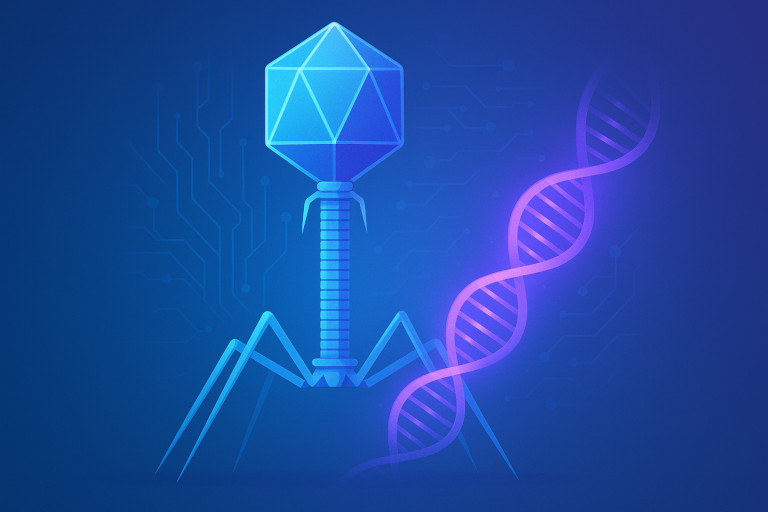September 17, 2025 — The Arc Institute reports a milestone in synthetic biology: a team led by Brian Hie and Samuel H. King used genome language models to design complete bacteriophage genomes, synthesized them, and showed in the lab that 16 AI designs were functional, infecting E. coli and replicating. This marks a practical move from reading and writing DNA to designing it.
What Was Built — and Why ΦX174?
The team chose the historic phage ΦX174 as a template: a compact genome of 5,386 nucleotides encoding 11 overlapping genes—small enough for cost-effective DNA synthesis, yet complex enough to stress-test genome-scale design. ΦX174 was the first completely sequenced (1977) and first fully chemically synthesized genome (2003); in 2025 it becomes the springboard for AI-designed genomes.
How the AI Design Works (High Level)
Researchers fine-tuned Evo genome language models on a curated Microviridae dataset and built a custom annotation pipeline to handle overlapping reading frames. They sampled hundreds of candidate genomes and filtered them for sequence quality, host specificity (E. coli C/W spike protein compatibility), and evolutionary novelty—then moved promising designs into synthesis and high-throughput assays.
Results by the Numbers
- 285 AI-designed genomes tested in 96-well growth-inhibition assays.
- 16 proved functional and were sequence-verified, propagated, and characterized.
- Functional phages remained host-restricted to E. coli C/W and did not grow on six other tested strains.
- Each viable phage carried 67–392 novel mutations vs. its nearest natural relative; Evo-Φ2147 showed 93.0% ANI, meeting common “new species” thresholds.
More Than a Rebuild: Real Novel Combinations
One standout, Evo-Φ36, incorporated the DNA packaging protein J from the distant phage G4—a combination that had defeated prior rational engineering. Cryo-EM revealed that the shorter G4 J protein (25 vs. 38 amino acids) adopted a distinct orientation in the capsid, implying the models coordinated compensatory mutations to make the hybrid work.
AI-Phages vs. Resistance
To probe resistance, the team evolved three E. coli strains resistant to ΦX174 (mutations in the waa operon). Cocktails of different AI-phages overcame resistance within 1–5 passages, whereas wild-type ΦX174 failed—suggesting that designed diversity can open multiple evolutionary routes around bacterial defenses.
Status and Caution
The work is a preprint (not yet peer-reviewed). Independent reporting and community reviews highlight the breakthrough as well as the need for robust governance: access controls around models and DNA synthesis, dual-use risk assessments, and transparent methodology that avoids cookbook-style details.
Opportunities, Risks, Next Steps
Medicine & agriculture: rapidly adaptable phage libraries against antibiotic-resistant pathogens and plant diseases. Risks: misuse, unclear regulatory readiness, and the challenge of benchmarking AI methods against simpler baselines. The authors point to larger DNA phages and clinically relevant targets (e.g., Pseudomonas aeruginosa, Xanthomonas) as realistic near-term goals as synthesis costs fall.
Key Takeaways
- First demonstration of AI-designed, full phage genomes; 16 functional in the lab.
- High novelty: up to 392 mutations; some below 95% ANI to natural relatives—potentially new species.
- Resistance tests: AI-phage cocktails beat ΦX174-resistant bacteria; wild-type failed.
- Status: preprint; early expert commentary urges careful governance.
Sources (verify & read more)
- Arc Institute — “How We Built the First AI-Generated Genomes” (Sep 17, 2025): arcinstitute.org/news/hie-king-first-synthetic-phage
- bioRxiv Preprint — “Generative design of novel bacteriophages with genome language models” (Sep 17, 2025): biorxiv.org/content/10.1101/2025.09.12.675911v1
- Nature News — “World’s first AI-designed viruses a step towards AI-generated life” (Sep 19, 2025): nature.com/articles/d41586-025-03055-y
- PREreview — Community review of the preprint (Sep 22, 2025): prereview.org/reviews/17178008
- GEN (Genetic Engineering & Biotechnology News) — Coverage & context (Sep 17, 2025): genengnews.com/…/ai-designs-viable-bacteriophage-genomes…

